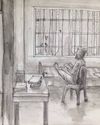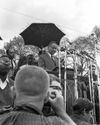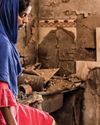
The decades-old Babri Masjid–Ram Janmabhoomi case has come to be the most intractable property dispute of our times. Most reports locate the starting point of the conflict at 1949, when Hindu idols were surreptitiously placed under the central dome of the Babri Masjid in the dead of the night. Years later, in 1984, the Vishwa Hindu Parishad started the Ram Janmabhoomi movement, mobilising Hindus across the country to build a temple on the disputed site. It ultimately led to the destruction of the mosque by mobs of kar sevaks—religious volunteers—in 1992, and communal bloodletting that left at least two thousand dead.
On 9 November 2019, a five-judge bench of the Supreme Court pronounced the eagerly anticipated final verdict on the resulting legal dispute. In a unanimous judgment, the court maintained that it had assessed the conflict primarily as a property dispute, or a title suit. “The dispute is over immovable property,” it stated. “The court does not decide title on the basis of faith or belief but on the basis of evidence. The law provides us with parameters as clear but as profound as ownership and possession.” Despite this exhortation, the court extended itself to hand over property rights over the entire disputed site to “Hindus,” on the premise that Hindu faith decreed that very site to be the birthplace of the epic hero Ram, who lived in the Ayodhya of the mythical Treta Yug.
This story is from the January 2020 edition of The Caravan.
Start your 7-day Magzter GOLD free trial to access thousands of curated premium stories, and 8,500+ magazines and newspapers.
Already a subscriber ? Sign In
This story is from the January 2020 edition of The Caravan.
Start your 7-day Magzter GOLD free trial to access thousands of curated premium stories, and 8,500+ magazines and newspapers.
Already a subscriber? Sign In

Mob Mentality
How the Modi government fuels a dangerous vigilantism

RIP TIDES
Shahidul Alam’s exploration of Bangladeshi photography and activism

Trickle-down Effect
Nepal–India tensions have advanced from the diplomatic level to the public sphere

Editor's Pick
ON 23 SEPTEMBER 1950, the diplomat Ralph Bunche, seen here addressing the 1965 Selma to Montgomery March, was awarded the Nobel Peace Prize. The first black Nobel laureate, Bunche was awarded the prize for his efforts in ending the 1948 Arab–Israeli War.

Shades of The Grey
A Pune bakery rejects the rigid binaries of everyday life / Gender

Scorched Hearths
A photographer-nurse recalls the Delhi violence

Licence to Kill
A photojournalist’s account of documenting the Delhi violence

CRIME AND PREJUDICE
The BJP and Delhi Police’s hand in the Delhi violence

Bled Dry
How India exploits health workers

Status Update
India’s telling silence on the Hagia Sophia controversy